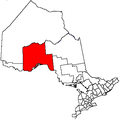Indian reserve in Ontario, Canada
| Pic River 50 | |
|---|---|
| Indian reserve | |
| Pic River Indian Reserve No. 50 | |
 | |
 | |
| Coordinates: 48°38′N 86°16′W / 48.633°N 86.267°W / 48.633; -86.267 | |
| Country | Canada |
| Province | Ontario |
| District | Thunder Bay |
| First Nation | Biigtigong Nishnaabeg |
| Area | |
| • Land | 3.65 km (1.41 sq mi) |
| Population | |
| • Total | 395 |
| • Density | 108.3/km (280/sq mi) |
| Website | www.picriver.com |
Biigtigong Nishnaabeg is an Ojibway (Anishinaabe) First Nation on the northern shore of Lake Superior. It is sometimes referred to as Ojibways of the Pic River First Nation (or "Pic River" for short). Pic River is not a signatory to the Robinson Superior treaty; however, they did petition, starting in 1879, for a reserve and the request was subsequently granted. The community is located on the northern shore of Lake Superior at the mouth of the Pic River 316.6-hectare (782-acre) and is called Pic River 50. In November 2007, their total registered population was 964 people, of which their on-reserve population was 480.
History
The mouth of the Pic River has been a center of native trade and settlement for thousands of years. It was a strategic location in the region's water transportation network because it offered access to northern lands and a canoe route to James Bay. The halfway point for canoers travelling the north shore of Lake Superior, "the Pic" first appeared on European maps in the mid-seventeenth century.
Local First Nations peoples traded furs with the French as early as the 1770s. A French fur trader set up a permanent post around 1792. The Hudson's Bay Company set up a permanent post in 1821 until encroaching settlement let to its relocation in 1888. In 1914, their Pic River 50 became a treaty-established reserve.
Reserve
Pic River 50 is an Indian reserve on the north shore of Lake Superior at the mouth of the Pic River, near Marathon, Ontario, Canada. The reserve is 316.6 ha within its exterior boundaries, and serves as the land-base for the Ojibways of the Pic River First Nation. In November, 2007, the First Nation reported their total registered population was 964 people, of which their on-reserve population was 480.
Pic River 50 is known for the role it has played in developing "run of the river" hydroelectric projects in Northern Ontario. It is partner to three projects: the 13.5 MW Black River generating station (GS), the 5.0 MW Twin Falls GS and the 23.0 MW Umbata Falls GS. In all, these projects produce enough electricity to meet the needs of some 30,000 homes in Ontario.
Ojibways of the Pic River First Nation are currently attempting to create a self-sustainable reserve with employment, education and resources being developed and used within the reserve itself. Thus far, Pic River 50 has a thriving forestry company, a cable television company and a high speed internet company.
The Pic River 50 reserve is home to many wild Northern Ontario species such as the beaver, moose, woodland caribou, wolf, black bear, white tailed and red tailed hawk, bald eagle, northern flicker, and many arctic alpine plants. The shores of Pic River 50 are dominated by the mass sandy dunes on the Little Pic river, which translates to "little muddy."
Culture
Pic River hosts an annual pow wow in mid July. The First Nation is active in economic and workforce development, with interests in run-of-the-river hydroelectric generating plants on the Kagiano River and Black River (Wawatay Generating Station).
Governance
The current electoral leadership of the council consists of Chief Duncan Michano and 11 councillors. Their four-year term began on October 30, 2021.
Notable people
- Rod Michano, a prominent HIV/AIDS awareness activist among First Nations in Canada.
In literature
The Voyageur, by Paul Carlucci, features some Nishnaabe characters.
References
- ^ "Pic River 50 census profile". 2011 Census of Population. Statistics Canada. Retrieved 17 June 2015.
- "Wawatay Generating Station". Regional Power. 2011. Retrieved 2014-07-23.
- Cecco, Leyland (2 August 2024). "'We didn't sign that treaty': in Canada, the Anishinaabe fight for land they never gave up". The Guardian. Retrieved 2 August 2024.
- Carlucci, Paul, The Voyageur
External links
- Ojibways of the Pic River First Nation's webpage
- AANDC profile
- Ontario Plaques - The Pic Fur Trading Post (Thunder Bay No. 41)
- Ontario Highway 11 Homepage - Pic River First Nation (off of Highway 17)
- FirstNation.ca profile
| Places adjacent to Biigtigong Nishnaabeg | ||||||||||||||||
|---|---|---|---|---|---|---|---|---|---|---|---|---|---|---|---|---|
| ||||||||||||||||
| Anishinabek Nation | |
|---|---|
| Lake Superior Region | |
| Lake Huron Region |
|
| Southwest Region | |
| Southeast Region | |
| Robinson Treaties | |
|---|---|
| Robinson Superior Treaty, 1850 | |
| Robinson Huron Treaty, 1850 | |
| Saugeen Surrenders, 1854 | |
| Pennefather Treaty, 1859 | |
| |
| Thunder Bay District, Ontario | ||
|---|---|---|
| Cities |  | |
| Towns | ||
| Townships | ||
| First Nations |
| |
| First Nations reserves |
| |
| First Nations settlements | ||
| Unorganized areas | ||
| Local services boards | ||
| Unincorporated communities |
| |